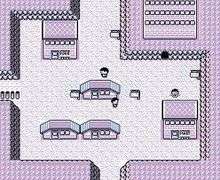Lavender Town
| Lavender Town | |
|---|---|
 Lavender Town as it appears in Pokémon Red and Blue | |
| Other name(s) | The Noble Purple Town |
| Located in | Kanto |
| Genre | Japanese role-playing game |
| Type | Village |
| First appearance | Pokémon Red and Blue |
| Last appearance | Pokémon Heart Gold and Soul Silver |
Lavender Town (Japanese: シオンタウン Hepburn: Shion Taun, Shion Town) is a fictional village in the Pokémon Red and Blue video games. Stylized as a haunted location, Lavender Town is home to a large Japanese-style graveyard. The background music of Lavender Town is renowned for adding to the town's eerie atmosphere, and gave rise to the Lavender Town Syndrome creepypasta, which suggests that over a hundred Japanese children committed suicide after listening to the track.
Background
Lavender Town is a very small village that can be visited in Pokémon Red, Blue, Yellow, Gold, Silver, Crystal, and the remakes thereof. It is home to the "Pokémon Tower", a Japanese-style graveyard filled with hundreds of tombstones for deceased Pokémon. Hence, the village is suggested to be a haunted location, and the player character can come across ghost-type Pokémon here. The Pokémon Tower was replaced by the "Kanto Radio Tower" in Pokémon Silver and Gold. Lavender Town is also home to the "Name Rater", which allows players to change the nickname of their Pokémon, and a care home for abandoned Pokémon.[1]
The Pokémon Tower makes an appearance in the first season of the Pokémon anime series, when its main characters search for ghost-type Pokémon for a difficult gym battle. Lavender Town also appears in the Pokémon Adventures and The Electric Tale of Pikachu manga series.[1]
Music and the Lavender Town Syndrome
The background music of Lavender Town has garnered much interest due to some listeners finding it unsettling. Listing it as the second-most scary video game track in 2012, Brittany Vincent of Bloody Disgusting stated that Lavender Town's "deceptively calm ... tune ranks highly on most gamers' lists of terrifying childhood memories." Lavender Town's music, composed by Junichi Masuda, combines sharp chiptune sounds with "a cavalcade of jarring chords" to create an eerie atmosphere.[2] Jay Hathaway of Gawker stated that leaving the music on loop may cause a "vague sense of dread".[3]
According to a creepypasta story that was uploaded anonymously on Pastebin in 2010, the music of Lavender Town compelled the suicide of over 100 Japanese children in the spring of 1996. Others allegedly suffered nosebleeds, headaches, or became irrationally angry. According to this urban legend, high pitch binaural beats harmed the brains of children in a way adults were immune to. This fabricated illness was dubbed "Lavender Town Syndrome" and the original story went viral after being spread on general interest websites such as 4chan. Various people have added details to make the story more convincing over time, such as Photoshopping images of ghosts into spectrogram outputs of the Lavender Town music.[3] Mark Hill of Kill Screen stated that the appeal of the Lavender Town Syndrome legend "comes from corrupting such an innocent symbol of childhood," and drew comparisons with "Dennō Senshi Porygon", an episode of the Pokémon anime series that gave hundreds of Japanese children seizures.[4][5]
The "Lavender Town" theme was rerecorded for the 2017 Pokémon Go Halloween event.[6]
Fan theory
The player character can battle their rival, Blue, in the Pokémon Tower. Fans of the series have noted that Blue's Raticate, a Pokémon he uses for every battle up to that point, does not appear in this fight or subsequent confrontations. This lead fans to speculate that Blue's Pokémon had died in a previous battle and that Blue came to the Pokémon Tower to bury and mourn his Raticate.[7]
References
- 1 2 Neves, Ravael (2012-02-29). "Stage Select: Lavender Town (Pokémon)". Nintendo Blast. Archived from the original on 2017-04-20.
- ↑ MolotovCupcake (2012-07-31). "The 10 Scariest Video Game Music Tracks". Bloody Disgusting. Archived from the original on 2017-04-20.
- 1 2 Hathaway, Jay (2015-03-12). "Lavender Town: The Bizarre Pokémon Child-Suicide Conspiracy Theory". Gawker. Archived from the original on 2016-10-21.
- ↑ Hill, Mark (2016-02-25). "The Lingering Appeal of Pokémon's Greatest Ghost Story". Kill Screen. Archived from the original on 2016-03-14.
- ↑ Hernandez, Patricia (2015-10-23). "Pokémon's Creepy Lavender Town Myth, Explained". Kotaku. Archived from the original on 2017-02-25.
- ↑ Francisco, Eric (2017-10-18). "Pokémon Go Halloween Event 2017: Are Gen 3 Pokemon Coming?". Inverse. Archived from the original on 2017-11-02.
- ↑ Roncero-Menendez, Sara (2013-10-12). "The 10 Most Bizarre Pokémon Fan Theories". Mashable. Archived from the original on 2017-04-20.